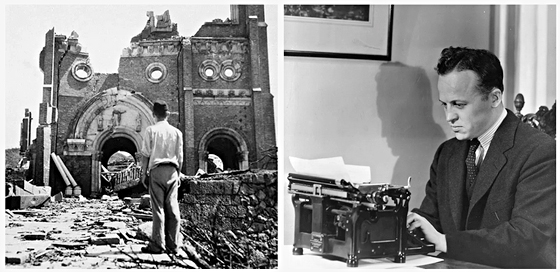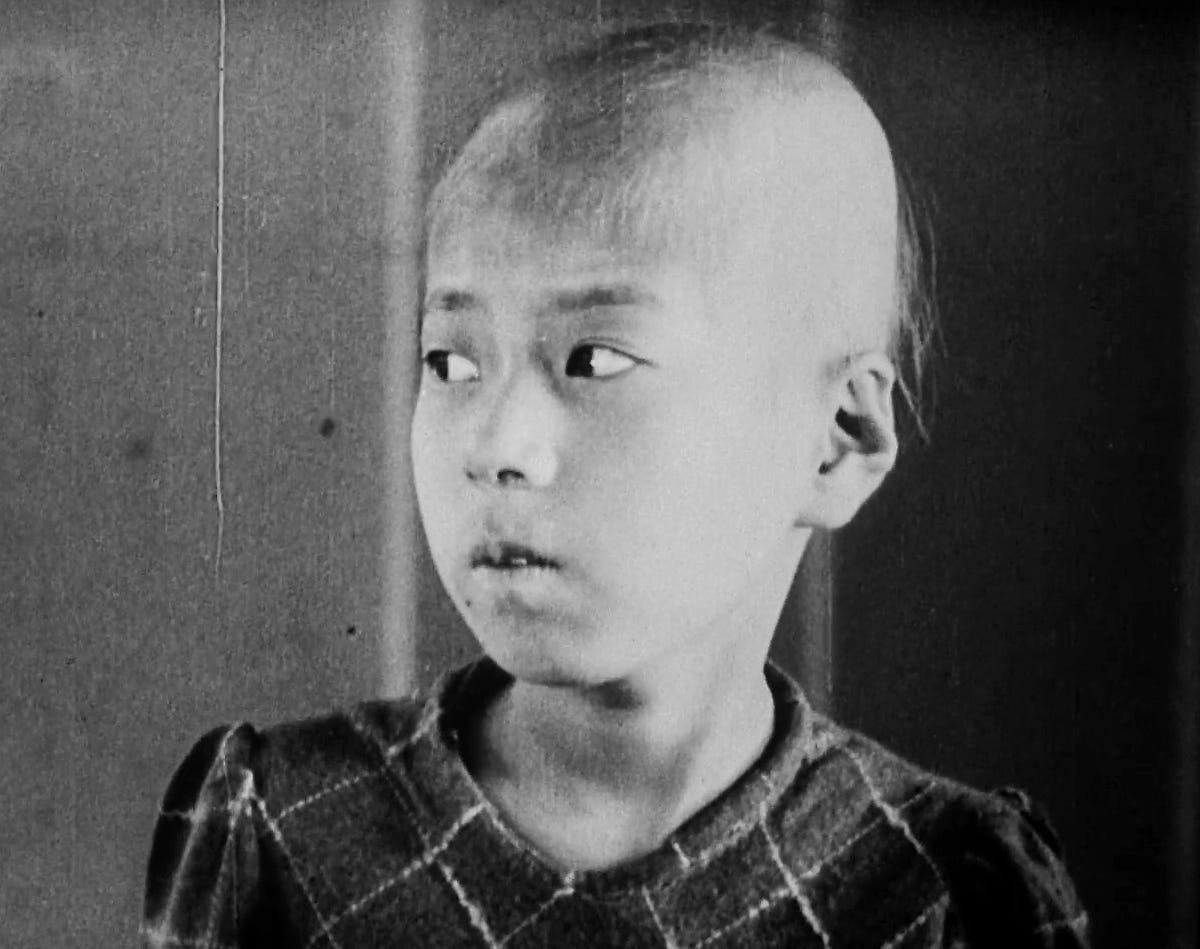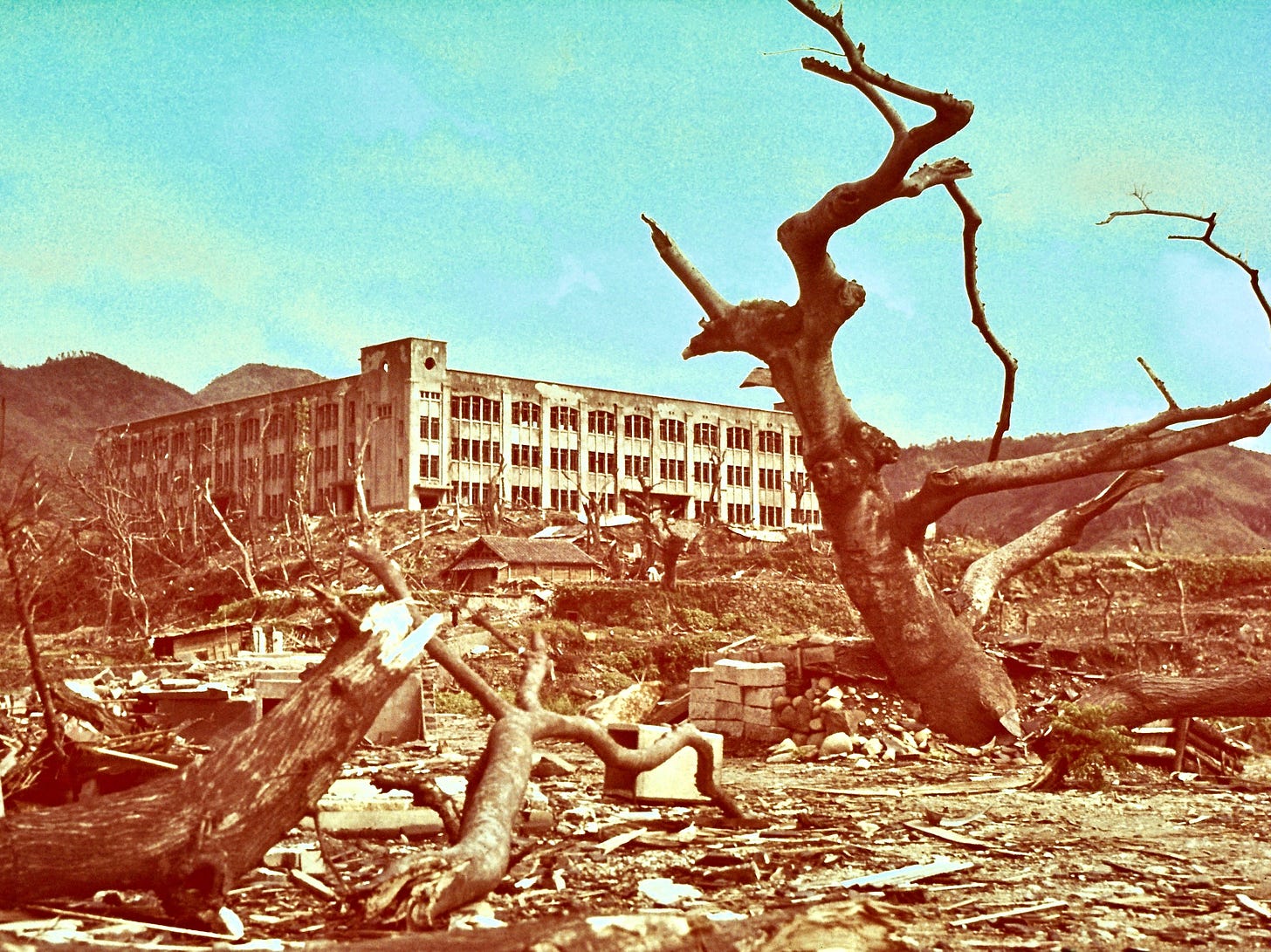Reprinted with permission from Greg Mitchell’s newsletter Oppenheimer: From Hiroshima to Hollywood.
 Yesterday’s post on the first article from Hiroshima here. You can still subscribe to this newsletter for free.
Yesterday’s post on the first article from Hiroshima here. You can still subscribe to this newsletter for free.
One of the great mysteries of the Nuclear Age was solved less than twenty years ago: What was in the censored, and then lost to the ages, newspaper articles filed by the first reporter to reach Nagasaki following the atomic attack on that city on August 9, 1945?
The reporter was George Weller (upper right), the distinguished correspondent for the now-defunct Chicago Daily News. His startling dispatches from Nagasaki, which could have affected public opinion on the future of the bomb, never emerged from General Douglas MacArthur’s censorship office in Tokyo.
Carbon copies of the stories were found in 2003 when his son discovered them after the reporter’s death. Four of them were published in 2005 for the first time by the Tokyo daily Mainichi Shimbun, which purchased them from the son, Anthony Weller. I was first to report on this in the United States.
The articles published in Japan (and later included in a book assembled by Anthony Weller, First Into Nagasaki) revealed a remarkable and wrenching turn in Weller’s view of the aftermath of the bombing, which anticipates the profound unease in our nuclear experience ever since. “It was remarkable to see that shifting perspective,” Anthony Weller told me.
An early article that George Weller filed, on Sept. 8, 1945 – two days after he reached the city, before any other journalist – hailed the “effectiveness of the bomb as a military device,” as his son describes it, and made no mention of the bomb’s special, radiation-producing properties.
But later that day, after visiting two hospitals and shaken by what he saw, he described a mysterious “Disease X” that was killing people who had seemed to survive the bombing in relatively good shape. A month after the atomic inferno, they were passing away pitifully, some with legs and arms “speckled with tiny red spots in patches.”
The following day he again described the atomic bomb’s “peculiar disease” and reported that the leading local X-ray specialist was convinced that “these people are simply suffering” from the bomb’s unknown radiation effects.
Anthony Weller, a novelist, told me that it was one of great disappointments of his father’s life that these stories, “a real coup,” were killed by MacArthur who, George Weller felt, “wanted all the credit for winning the war, not some scientists back in New Mexico.”
Others have suggested that the real reason for the censorship was the United States did not want the world to learn about the morally troubling radiation
effects for two reasons: It aimed to avoid questions raised about the use of the weapon in 1945, or its wide scale development in the coming years. In fact, an official “coverup” of much of this information – involving print accounts, photographs and film footage – continued for years, even, in some cases, decades (see my book and film, Atomic Cover-up).
“Clearly,” Anthony Weller told me of his father’s reports, “they would have supplied an eyewitness account at a moment when the American people badly needed one.”

How did George Weller get the scoop-that-wasn’t?
After years of covering the Pacific war, Weller arrived in Japan with the first wave of reporters and military in early September. He had already won a Pulitzer for his reporting in 1943. Appalled by MacArthur’s censors, and “the conformists” in his profession who went along with strict press restrictions, he made his way, with permission, to the distant island of Kyushu to visit a former kamikaze base. But he noted that it was connected by railroad to Nagasaki.
Pretending he was “a major or colonel,” as his son put it, he slipped into the city (perhaps by boat) about three days before any of his colleagues, and just after Wilfred Burchett had filed his first report from Hiroshima.
Once arrived, Weller toured the city, the aid stations, the former POW camps, and wrote numerous stories within days. According to his son, he managed to send the articles to Tokyo, not by wire, but by hand, and felt “that the sheer volume and importance of the stories would mean they would be respected” by MacArthur and his censors.
Although Weller did not express any outward disapproval of the use of the bomb, these stories – and others he filed in the following two weeks from the vicinity – would never see the light of the day, and the reporter lost track of his carbons. He would later summarize the experience with the censorship office in two words: “They won.”
In the years that followed, Weller continued his journalism career, winning a George Polk award and other honors and covering many other conflicts. Neither the carbons nor the originals ever surfaced, before he passed away in 2002 at the age of 95. It was then that his son made a full search of the wildly disorganized “archives” at his father’s home in Italy, and in 2003 found the carbons just 30 feet from his dad’s desk.
And what a find: roughly 75 pages of stories, on fading brownish paper, that covered not only his first atomic dispatches but gripping accounts by prisoners of war, some of whom described watching the bomb go off on that fateful morning.
In the first article, Weller described himself as “the first visitor to inspect the ruins.” He suggested about 24,000 may have died but he attributed the numbers (actually well off the actual total) to “inadequate” air raid shelters and the “total failure” of the air warning system. He declared that the bomb was “a tremendous, but not a peculiar weapon,” and said he spent hours in the ruins without apparent ill effects. He did note, with some regret, that a hospital and an American mission college were destroyed, but pointed out that to spare them would have also meant sparing munitions plants.
In his second story that day, however, following his hospital visits, he would describe “Disease X,” and victims, who have “neither a burn or a broken limb,” wasting away with “blackish” mouths and red spots, and small children who “have lost some hair.”
A third piece, sent to MacArthur the following day, reported the disease “still snatching away lives here. Men, women and children with no outward marks of injury are dying daily in hospitals, some after having walked around three or four weeks thinking they have escaped. The doctors … candidly confessed … that the answer to the malady is beyond them.” At one hospital, 200 of 343 admitted had died: “They are dead – dead of atomic bomb – and nobody knows why.”
He closed this account with: “Twenty-five Americans are due to arrive Sept. 11 to study the Nagasaki bomb site. Japanese hope they will bring a solution for Disease X.”
To this day, a solution for the disease – and the threat of nuclear weapons – has still not arrived.
See my recent article on the Nagasaki bombing at Mother Jones. My book Atomic Cover-up) reveals how the most shocking and important footage shot by a Japanese newsreel team and an elite U.S. Army unit in Nagasaki and Hiroshima was also buried for decades.
Thanks for reading Oppenheimer: From Hiroshima to Hollywood! Subscribe for free to receive new posts and support my work.
Greg Mitchell is the author of a dozen books, including “Hiroshima in America,” and the recent award-winning The Beginning or the End: How Hollywood – and America – Learned to Stop Worrying and Love the Bomb, and has directed three documentary films since 2021, including two for PBS (plus award-winning “Atomic Cover-up”). He has written widely about the atomic bomb and atomic bombings, and their aftermath, for over forty years. He writes often at Oppenheimer: From Hiroshima to Hollywood.



